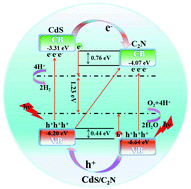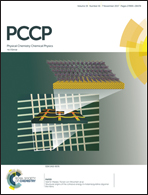A two-dimensional layered CdS/C2N heterostructure for visible-light-driven photocatalysis†
Abstract
In this work, we employ hybrid density functional theory calculations to design a two-dimensional layered CdS/C2N heterostructure for visible light photocatalytic water splitting to produce hydrogen. The calculation results show that the conduction band minimum (CBM) and the valence band maximum (VBM) of C2N monolayers are lower than those of CdS nanosheets by about 0.76 eV and 0.44 eV, respectively. The type-II band alignment, density of states, Bader charge analysis, and charge density difference of the CdS/C2N heterostructure indicate that the photogenerated electrons migrate from the CdS monolayer to the C2N monolayer, favoring the separation and transfer of photogenerated charge carriers, which restrains the recombination of photogenerated carriers and enhances the photocatalytic efficiency. The calculated band gap and optical absorption spectra reveal that the two-dimensional layered CdS/C2N heterostructure may be a potential photocatalyst for photo-electrochemical water splitting because of its appropriate band gap and excellent visible light absorption behavior. Moreover, the electronic and optical properties of the CdS/C2N heterostructure can be effectively modulated by the strain. These findings suggest that the C2N sheets are a promising candidate as metal-free co-catalysts for CdS photocatalysts, and also provide valuable information for experimentalists to design highly active and efficient visible light photocatalysts for water splitting.



 Please wait while we load your content...
Please wait while we load your content...